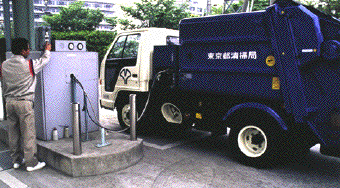
Natural gas-powered vehicles are kinder to the environment.
(Photo: Tokyo Gas Co.)
NATURAL GAS-POWERED VEHICLES:
Industry Promotes Environmentally Friendly Cars
JUNE 13, 1996

Natural gas-powered vehicles are kinder to the environment.
(Photo: Tokyo Gas Co.)
800 Vehicles on the Road
Natural gas vehicles are considered the nearest to commercial viability among low emission vehicles, and gas companies and car manufacturers have begun a drive to promote their wider use.
Natural gas is a chemical compound consisting of carbon and hydrogen. It contains virtually no sulfur or impurities. This means that even when used as automotive fuel, emissions contain no sulfur oxide and minimal amounts of nitrogen oxide.
The volume of carbon dioxide, the primary cause of global warming, produced is said to be 20% to 30% less than with gasoline or diesel fuel. Natural gas cars are thus much kinder to the environment than those that run on gasoline, diesel, or propane.
Natural gas-powered vehicles are already running on our streets. Their most common use is as commercial vehicles, such as maintenance cars for gas companies. Many garbage collection trucks, pollution patrol vehicles, commuter buses, and delivery trucks for food cooperatives are also being powered by natural gas. The total number of such vehicles in Japan, though, is still less than 800.
Hurdles to be Overcome
A number of factors are to blame for the small number. For one thing, the tanks used to store natural gas are too heavy. They are made of steel measuring 1 millimeter thick; to carry enough fuel for a passenger car, a tank would have to be slightly bigger than a golf bag and would weigh some 100 kilograms, dampening fuel efficiency and hampering performance. Gas companies are therefore developing light-weight tanks using aluminum and coating the outer surface with fiberglass for added strength.
The second problem is price. All natural gas-powered vehicles in use today have been built by converting gasoline or diesel models. This costs money, doubling or tripling the price of the car. To promote the general use of these vehicles, mass production is required. Car manufacturers are taking steps in this direction, with moves that include the production of trial models.
Thirdly, roadside refueling stations similar to gasoline stations are needed. Less than 40 such facilities exist right now, and so increasing their number is critical to the spread of natural gas vehicles.
The government hopes to see the number of natural gas-powered vehicles increase to 200,000, or 250 times current levels, by the year 2000. Measures such as tax incentives are being formulated to support such growth.